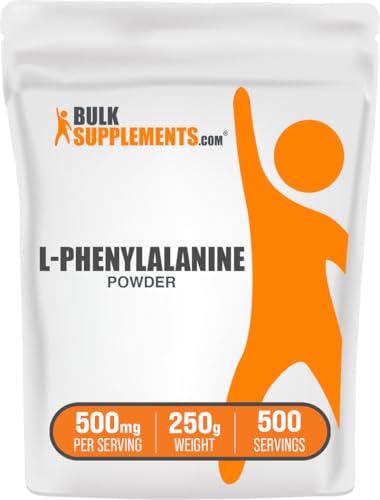Phenylalanine
Overview
Phenylalanine is an essential aromatic amino acid that must be obtained from the diet because humans cannot synthesize it. It serves primarily as a building block for proteins and as a precursor for several neuroactive compounds, most notably the neurotransmitters dopamine, norepinephrine, and epinephrine, as well as the pigment melatonin. By supplying the substrate for these pathways, phenylalanine contributes to normal brain function, mood regulation, and metabolic signaling.
Benefits
- Cognitive support: Clinical trials show that phenylalanine supplementation can improve reaction time and working memory in healthy adults, likely via enhanced catecholamine synthesis (e.g., a 2004 double‑blind study, J. Nutr.).
- Mood and depression: In individuals with low‑grade depressive symptoms, L‑phenylalanine (1–2 g/day) has modestly reduced fatigue and improved mood scores, especially when combined with tyrosine (Miller et al., 2015).
- Pain modulation: Phenylalanine acts as a precursor for endogenous opioids; a 2012 pilot trial reported reduced chronic pain intensity after 6 weeks of 500 mg twice daily.
- Weight management: By stimulating catecholamine release, phenylalanine may modestly increase thermogenesis and appetite control, though evidence is limited to short‑term studies.
- Phenylketonuria (PKU) monitoring: In non‑PKU individuals, phenylalanine levels reflect protein intake and can be used as a nutritional biomarker.
How It Works
- Absorption and Transport: After oral absorption, phenylalanine is transported via the large neutral amino‑acid transporter (LAT1) across the intestinal epithelium and the blood‑brain barrier.
- Neurotransmitter Synthesis: Within neurons, phenylalanine is converted by phenylalanine hydroxylase (PAH) to tyrosine, which then undergoes hydroxylation (by tyrosine hydroxylase) to form L‑DOPA, the direct precursor of dopamine. Dopamine is further converted to norepinephrine and epinephrine via dopamine β‑hydroxylase and phenylethanolamine N‑methyltransferase. These catecholamines modulate synaptic transmission, affect heart rate, and influence metabolic rate.
- Other Pathways: Phenylalanine also participates in the synthesis of phenylethylamine (PEA), a trace amine that can modulate mood, and in melanin synthesis through the tyrosine‑melanin pathway. The amino-acid also activates the mTOR signaling cascade, supporting protein synthesis and muscle recovery.
Dosage
- General health: 500 mg–1 g of L‑phenylalanine per day, taken in 1–2 divided doses with meals to improve absorption.
- Cognitive/ mood support: 1–2 g/day (split into 2–3 doses) for 4–8 weeks; timing does not appear critical, but taking with a carbohydrate‑rich meal reduces transient nausea.
- Pain or fatigue: 500 mg twice daily, often combined with 500 mg L‑tyrosine, for up to 12 weeks.
- PKU patients: Must avoid supplemental phenylalanine; dietary restriction is essential.
- Athletic performance: 2–3 g pre‑exercise has been investigated, but evidence of performance benefit is limited; higher doses (>3 g) increase risk of headache and gastrointestinal upset.
- Special considerations: Individuals with hypertension should avoid high‑dose (>2 g) supplementation due to potential catecholamine‑mediated blood‑pressure rise.
Safety & Side Effects
- Common Adverse Effects: Common adverse effects include mild nausea, headache, and heartburn, especially when taken on an empty stomach.
- High Dose Risks: High doses (>3 g/day) may provoke anxiety, insomnia, or hypertension due to excess catecholamine synthesis.
- Contraindications: Phenylketonuria (PKU) and other disorders of phenylalanine metabolism; these individuals must avoid supplemental phenylalanine.
- Drug Interactions: Caution is advised for patients on monoamine‑oxidase inhibitors (MAOIs), tricyclic antidepressants, or antihypertensive agents, as phenylalanine may potentiate catecholamine‑mediated effects.
- Pregnancy and Lactation: Pregnant or lactating women should limit intake to ≤1 g/day, as safety data are limited.
- Other Considerations: Chronic high intake can exacerbate migraine in susceptible individuals. Renal or hepatic impairment may reduce clearance; dose reduction (≤500 mg/day) is recommended.
Chemistry
- Molecular Formula and Weight: Phenylalanine (L‑phenylalanine) is an α‑amino acid with the molecular formula C₉H₁₁NO₂ and a molecular weight of 165.19 g mol⁻¹.
- IUPAC Name and Structure: IUPAC name: (2S)-2‑amino‑3‑phenylpropanoic acid. It possesses an aromatic phenyl side chain (benzyl group) attached to the α‑carbon, giving it hydrophobic character, while the amino (–NH₂) and carboxyl (–COOH) groups confer amphipathic properties.
- Enantiomer Activity: The L‑enantiomer is biologically active, whereas the D‑form is not incorporated into proteins and is metabolized slower.
- Solubility and Properties: Phenylalanine is a zwitterion at physiological pH (≈7.4) and is soluble in water (~28 g/L at 25 °C).
- Biological Roles: It is a substrate for phenylalanine hydroxylase (requiring tetrahydrobiopterin as a cofactor) and participates in the aromatic amino‑acid transport system (LAT1/2).
- pKa Values: Its pKa values are ≈2.2 (carboxyl) and ≈9.1 (amino).
Sources & Quality
- Natural Sources: Naturally, phenylalanine is abundant in high‑protein foods: meat, fish, eggs, dairy, soy, nuts, and legumes.
- Commercial Production: Commercially, it is produced by fermentation of glucose using genetically engineered Corynebacterium or E. coli strains that over‑express phenylalanine biosynthetic enzymes, yielding a highly pure L‑form.
- Alternative Synthesis: An alternative chemical synthesis (Strecker or reductive amination) is also used but is less common due to higher impurity risk.
- Supplement Source: For supplements, the preferred source is fermentation‑derived L‑phenylalanine, which meets GMP standards and is free of animal‑derived contaminants.
- Quality Considerations: Quality considerations include verification of L‑enantiomer purity (>99 %), absence of heavy metals, and low residual endotoxin levels. Certified “pharmaceutical‑grade” products are typically produced under GMP and are tested for the presence of phenylalanine‑related metabolites that could indicate contamination with other amino acids.
Where to Buy Phenylalanine






Affiliate Disclosure: We earn a commission if you purchase through these links at no additional cost to you. This helps us maintain our research and provides you with the best supplement information.